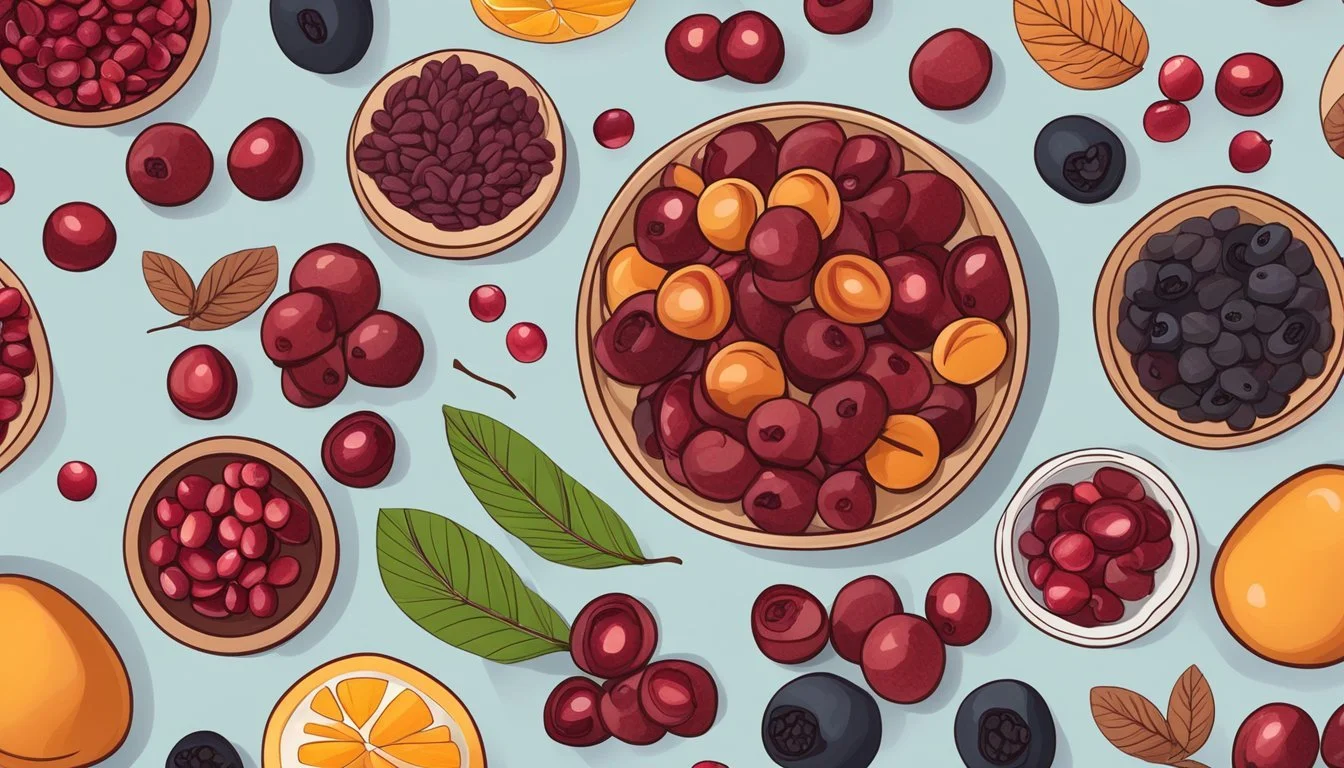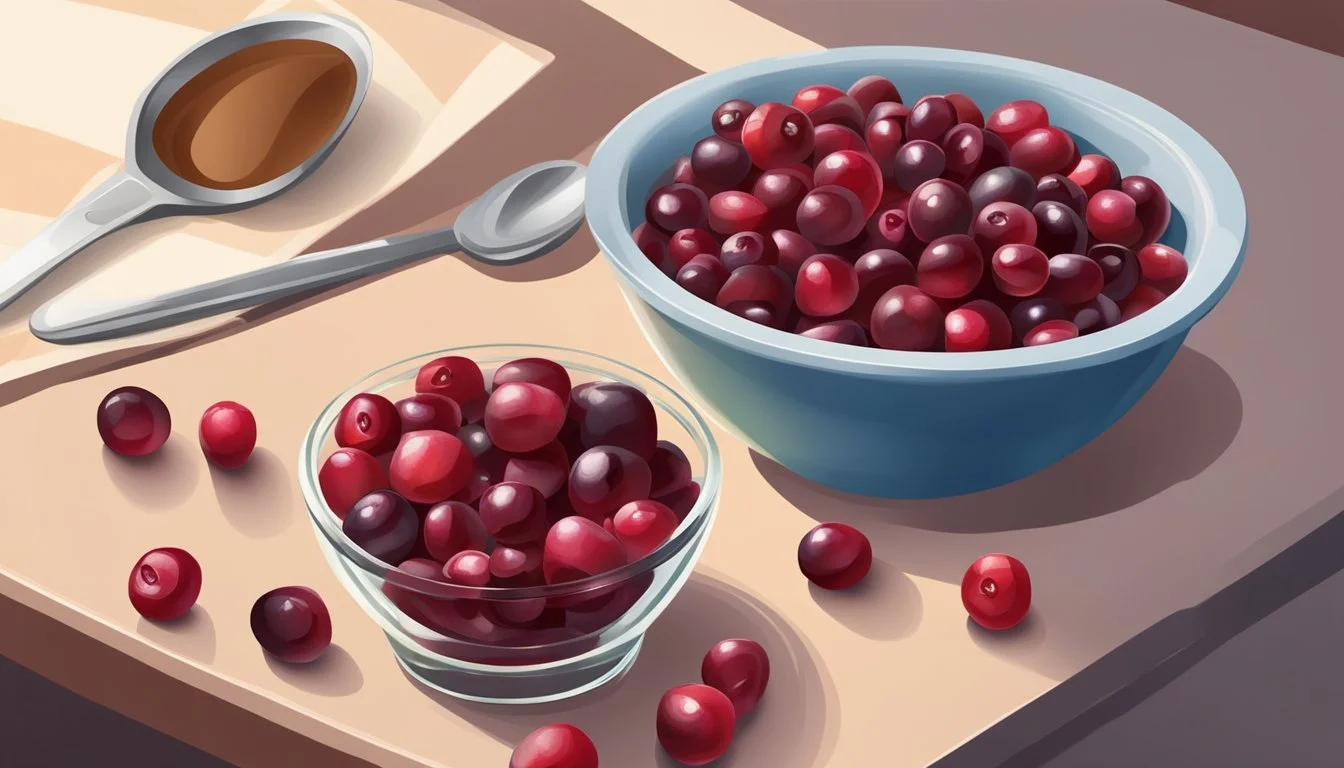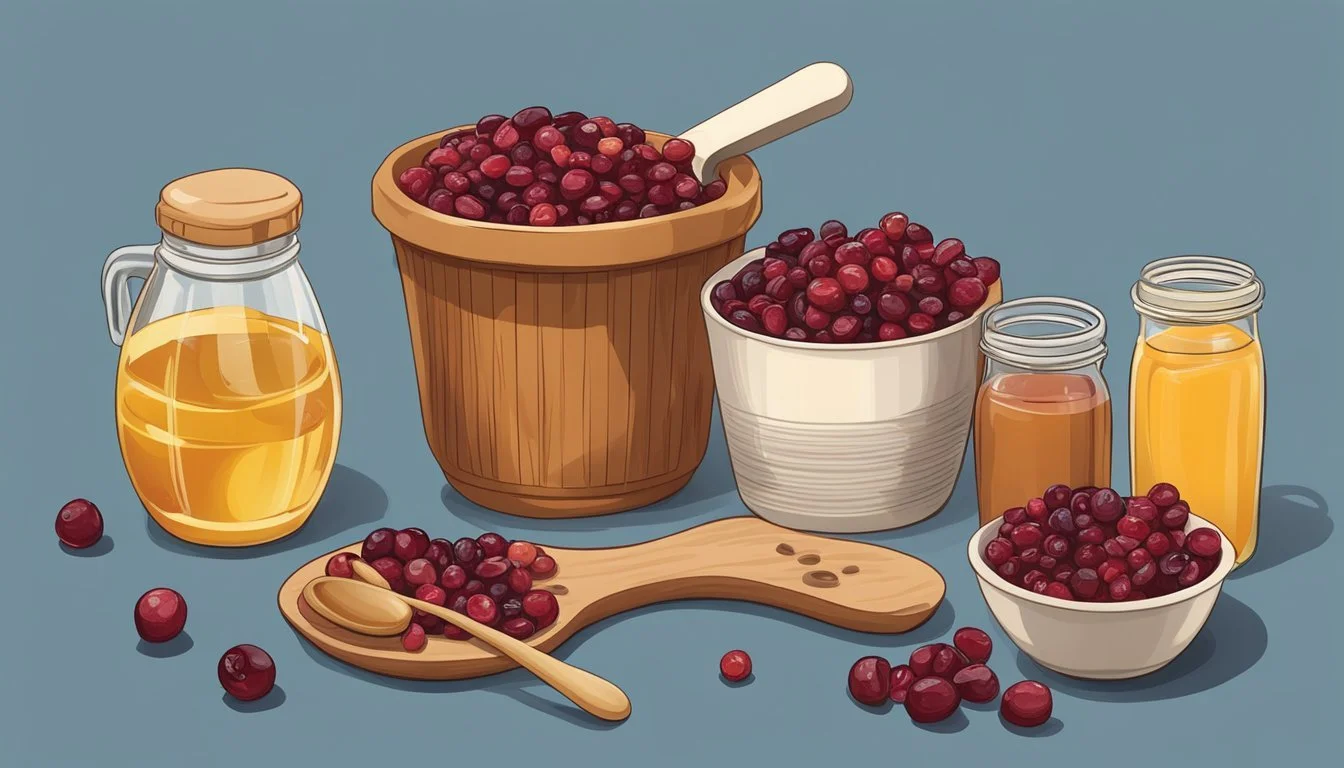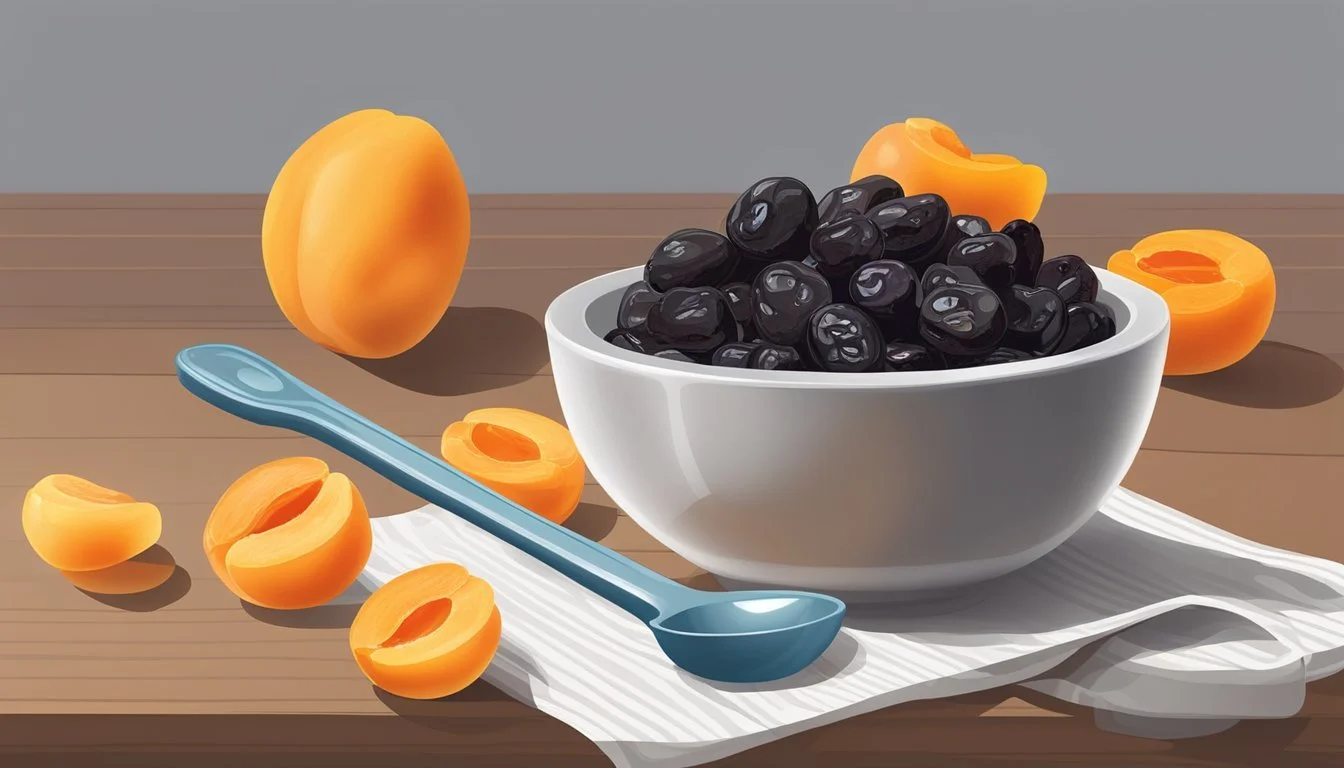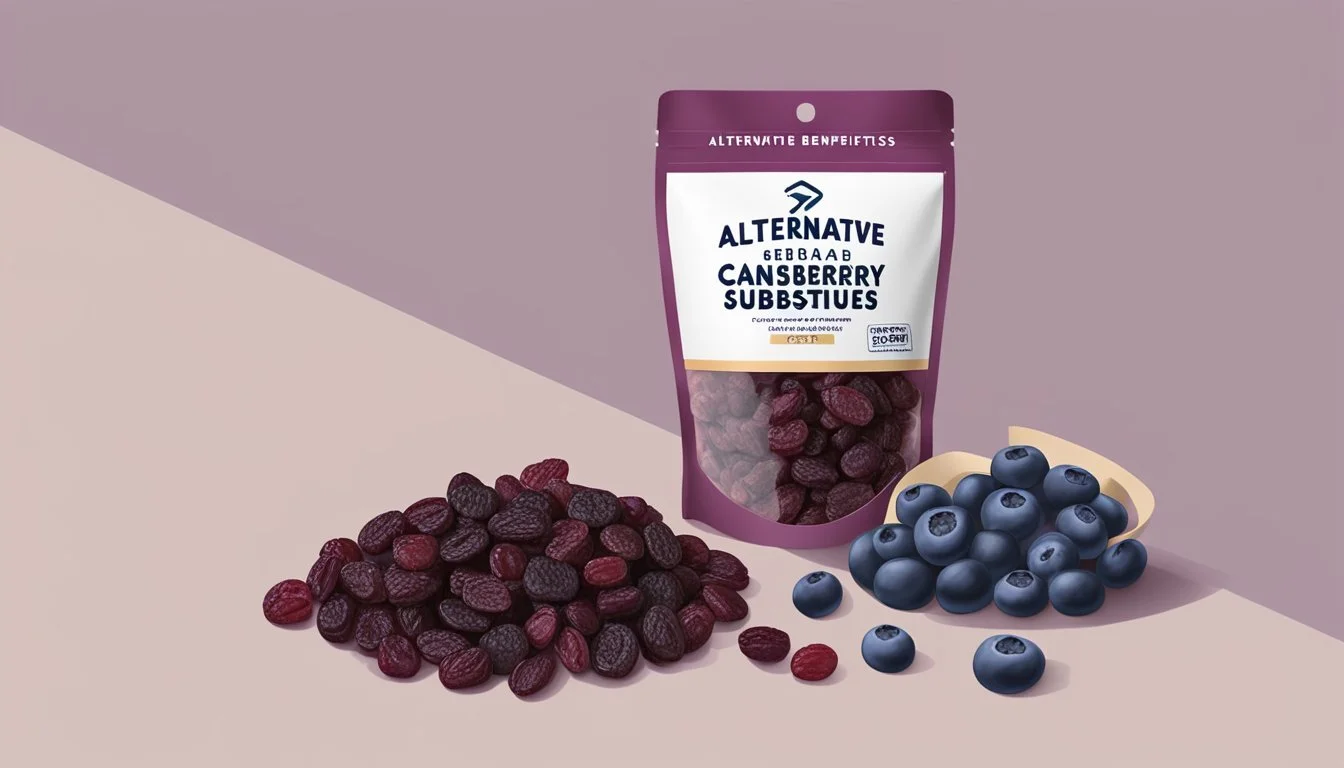Dried Cranberry Substitutes
Top Alternatives for Your Recipes
Dried cranberries are popular for their distinct tart flavor and chewy texture, making them a favorite in a variety of recipes ranging from baked goods to salads. They not only add a punch of flavor but also bring a splash of color to dishes. While these little fruits are versatile and nutritious, offering health benefits such as high fiber content and antioxidants, there might be instances where a cook finds themselves without dried cranberries at hand or wishes to explore different flavor profiles in their cooking.
In such cases, there are several substitutes that can mimic the characteristics of dried cranberries to some extent. Dried apricots provide a similar chewiness and a sweet contrast, while cherries can offer a bold red color to dishes that require the visual appeal of cranberries. Each alternative brings its own unique flavor and texture that can enhance a variety of recipes. When selecting a substitute, one should consider factors such as the sweetness or tartness of the alternative, as it may necessitate adjustments in the recipe's other ingredients to maintain the desired end-product.
Identifying the right cranberry substitute can be crucial for both the taste and appearance of culinary creations. While alternatives like dried apricots or cherries are commonly recommended, other fruits like raspberries can also serve as an adequate replacement, especially in baked goods and sweets. These substitutes are not only chosen to closely match the original ingredient's properties but are also selected based on how they complement the dish's overall flavor profile. Choosing the appropriate cranberry substitute can ensure that the intended flavors of the recipe are preserved or even enhanced.
Understanding Cranberries
Cranberries are a versatile fruit known for their distinct tart flavor and potential health benefits. They come in various forms, including fresh, dried, and frozen, tailored to different culinary uses.
Cranberry Characteristics
Cranberries, either fresh or frozen, are notably tart and sour in taste, which can be mellowed through cooking or by adding sweeteners. These small, red berries are rich in fiber and antioxidants, which contribute to their signature bold taste and deep red color. Fresh cranberries are firm and bounce when dropped, a fun test for their freshness commonly known as the "bounce test." On the other hand, dried cranberries are slightly sweeter due to the sugar added during the drying process, and they have a chewier texture.
Fresh cranberries: Tart, firm, suitable for sauces and baking.
Dried cranberries: Sweetened, chewy, used as a snack or in baked goods.
Frozen cranberries: Convenient, retain many of the properties of fresh cranberries.
Health Benefits of Cranberries
Cranberries are not just a festive staple; they are also packed with valuable nutrients. They contain vitamins C and E, essential for immune function and skin health, respectively. The fiber in cranberries aids digestion, while their antioxidants have been linked to a plethora of benefits ranging from anti-inflammatory effects to urinary tract health. It is important to note that consuming cranberries in their whole form maximizes these health benefits, as opposed to overly processed forms.
Vitamins: Cranberries are a good source of Vitamin C and E.
Fiber: Promotes digestive health.
Antioxidants: Help protect the body against free radical damage.
Common Cranberry Substitutes
When a recipe calls for dried cranberries, several alternatives can provide a similar texture or flavor profile. Understanding these substitutes can help maintain the integrity of the dish while allowing for creative adaptations.
Berry Alternatives
For recipes requiring a berry appearance and taste, several berry substitutes can be employed:
Cherries: Provide a bold red color and are larger than cranberries. Ideal for sauces or jellies where a rich red hue is desired.
Dried Blueberries: Offer sweet and slightly tangy notes, making them a good stand-in for cranberries in baked goods.
Raspberries: Work well in dishes that can handle a softer texture and more intense sweetness.
Currants: Both red and black currants can substitute for cranberries due to their tart flavor profile, especially in jams and syrups.
Berry Type Flavor Note Best Used In Cherries Bold and sweet Sauces, Jellies Dried Blueberries Sweet-tart Baked Goods Raspberries Intensely sweet Compotes, Desserts Currants Tart, rich in Vitamin C Jams, Syrups
Dried Fruit Varieties
Dried fruits provide a comparable texture to dried cranberries and can be incorporated into a variety of recipes:
Raisins: They are readily available and can be used in most recipes due to their similar size and sweetness.
Dried Apricots: They are sweet with a hint of tartness, suitable for tea, beverages, or as a topping.
Dried Fruit Taste Profile Ideal Pairing Raisins Sweet, sun-dried Cookies, Breads Dried Apricots Sweet with tartness Teas, Oatmeal
Other Substitutes
Apart from dried fruits, there are non-berry alternatives that can mimic the tartness or texture of cranberries:
Lingonberries: Less common but similar in taste, these can be used when a tart berry flavor is essential.
Chopped Stone Fruits: Peaches or nectarines can also be dehydrated and utilized as a sweeter cranberry replacement.
Each substitute behaves differently when used in cooking or baking, and modifications may need to be made to the original recipe to accommodate the change in sweetness, moisture, and texture.
Substitution in Recipes
Replacing dried cranberries in recipes allows for creative variations in taste and texture, while keeping in mind the balance of sweetness and tartness that cranberries typically provide. Careful consideration of substitutes ensures each dish retains its intended deliciousness.
Baked Goods
For muffins and cakes where dried cranberries lend a tart zing and chewy texture, cherries make an excellent alternative. They maintain a similar bold color and can be chopped to resemble the size of cranberries. When using sweeter substitutes like dried apricots or cherries, one should consider reducing added sugars by 10-25% to account for the natural sweetness of the fruit.
Cherries: Maintain color; mimic tartness with less sugar.
Dried Apricots: Offer sweetness; reduce sugar; chop for texture similarity.
Sauces and Condiments
In sauces and condiments where consistency and color are important, fruits like cherries can replicate the vibrant hue of cranberries. For jellies and jams, fruits with a balance of sweetness and tartness, such as black currants or raspberries, are suitable. They provide the required pectin-rich nature for proper set and spreadability.
Cherries: Suitable for sauces needing rich red coloring.
Black Currants/Raspberries: Offer tartness and pectin for jellies and jams.
Salads and Savory Dishes
Dried cranberries often add a sweet-tart contrast in savory salads and dishes. One can substitute them with fruits like dried apricots for sweetness or with tart black currants or raspberries. The chosen fruit should complement the other ingredients in the dish and align with the desired flavor profile.
Dried Apricots: Sweeten salads; balance savory elements.
Black Currants/Raspberries: Provide tartness in savory dishes.
Adjusting Flavor and Sweetness
When substituting dried cranberries, one must carefully balance the sweetness and acidity to achieve the desired flavor profile of a dish.
Managing Sugar Content
To manage the sweetness in recipes, one should first consider the natural sugar content of the substitute. If a substitute is sweeter than cranberries, one can reduce the amount of added sugar. For example, when using dried cherries, which have a naturally sweet flavor, they may choose to cut back on extra sugar by 10-25%. On the other hand, a less sweet option like raisins may require little to no reduction in the recipe's sugar content.
If the substitute is sweeter: Reduce extra sugar in the recipe by 10-25%.
If the substitute is less sweet: Maintain or slightly increase extra sugar in the recipe.
Adding Acidity or Tanginess
Certain dried fruits lack the tangy flavor characteristic of cranberries, which might affect the desired sour flavor in a dish. To introduce acidity, one could add a modest amount of lemon juice. This will enhance the tanginess without overwhelming the dish. A squeeze of lemon juice can provide the needed acidity to balance out the overall flavor.
To enhance tanginess: Add a squeeze of lemon juice.
To adjust acidity levels: Taste and add acidity incrementally, being careful not to alter the core taste profile.
Special Considerations
When choosing a dried cranberry substitute, it's important to consider how the alternative will affect texture and moisture, visual appearance, and nutritional profile of the dish. The right substitute not only matches the flavors but also supports the desired outcome in terms of these factors.
Texture and Moisture
Dried cherries and raisins are the most common substitutes for dried cranberries. They offer a similar chewy texture, making them suitable for baked goods and salads where a bit of chewiness is desirable. Raisins typically have higher moisture content, which could lead to a softer consistency in recipes. To maintain balance, one might need to adjust other wet ingredients or cooking times appropriately.
Visual Appearance
The visual appeal of a dish can be significantly influenced by the chosen substitute. Cherries, with their bold red color, are closer in appearance to cranberries and are excellent for maintaining the vibrant look in sauces and jellies. On the other hand, using raisins or other dried fruits like apricots, prunes, or blueberries, while still appealing, may alter the color palette of the finished dish.
Nutritional Differences
Each substitute carries its unique nutritional profile. Dried cranberries are known for their fiber content and antioxidants. Alternatives like dried cherries also contain antioxidants but differ in vitamin and mineral content. The table below compares the nutritional content of dried cranberries to that of cherries and raisins per typical serving sizes:
Nutrient Dried Cranberries Dried Cherries Raisins Calories 123 130 129 Fiber (g) 3.6 3.0 1.6 Sugar (g) 26 20 25 Antioxidants High High Moderate Vitamin C (mg) 0.1 10.8 2.3 Iron (mg) 0.25 0.5 0.75
Note: The values are approximate and can vary by brand and processing techniques.
Substitutes provide various health benefits, but it's vital to align them with dietary preferences and restrictions. One must be mindful of added sugars or preservatives that may come with certain brands of dried fruits.
Seasonal and Regional Availability
When seeking alternatives to dried cranberries, one must consider the availability of potential substitutes which can vary by region and season. This section provides guidance in finding appropriate replacements during different times of the year and in various locations.
Finding Substitutes in Grocery Stores
Grocery stores typically stock a variety of dried fruits year-round, with selections that can effectively replace dried cranberries in recipes. Shoppers should look for:
Dried cherries: They offer a tartness similar to cranberries and are often readily available.
Raisins: Commonly found in stores, raisins are sweeter but can serve as a versatile substitute.
During certain holidays like Thanksgiving and Christmas, grocery stores in North America may expand their dried fruit offerings, making it easier to find suitable substitutes.
Local and Seasonal Options
Summer and Autumn: Fresh local produce is abundant. In these seasons, cooks can often find fresh berries and fruits that can be dried or used fresh in place of cranberries. For example:
In summer, fresh cherries or blueberries can be dried at home and used as substitutes.
Autumn, leading up to Thanksgiving, may provide a bounty of fresh cranberries and other fruits in North American markets, offering ample opportunity for preservation or direct use in festive dishes.
During the holidays, some regional options may become more prevalent in local markets. This allows individuals to incorporate local flavor into traditional recipes that call for cranberries.
Culinary Applications
When substituting dried cranberries in recipes, it's essential to consider the taste and texture that alternative ingredients will bring to the dish.
Desserts and Confectioneries
Cakes and Cupcakes: Substitutes like dried cherries or dried apricots, chopped to size, can add a tartness similar to cranberries. They work well in batter mixes and maintain a chewy texture after baking.
Cookies and Tarts: Raisins, with their sweet and slightly tart flavor profile, can be directly substituted for dried cranberries. Their chewy texture lends a contrasting mouthfeel, ideal for cookie doughs and tart fillings.
Crumbles and Muffins: For a twist in crumbles and muffins, incorporating dried goji berries introduces a unique flavor. Their subtle tartness and chewy texture pair nicely with the typical sweetness of these desserts.
Main Dishes and Side Dishes
Cranberry Sauce and Jelly: When making cranberry sauce or jelly, one can use cherries to achieve a rich red color and similar boldness in taste.
Fillings: In savory applications, like stuffing for main dishes, use alternatives such as dried cherries or dried apricots for a balanced tartness. This can closely mimic the tangy kick that cranberries would traditionally provide.
Using these substitutes, cooks and bakers can confidently bridge the gap left by the absence of dried cranberries in their culinary creations.
Alternative Benefits
When considering dried cranberry substitutes, one should look at the nutritional profiles and the capacity of these alternatives to cater to allergies and dietary restrictions.
Nutritional Profiles of Substitutes
Substitutes for dried cranberries come with their own unique nutritional advantages. Dried cherries, for instance, are a substantial source of vitamins A and C, and like cranberries, they offer a good amount of fiber and antioxidants. Dried apricots stand out due to their high fiber content and potassium levels, beneficial for heart health. Currants and raisins contribute significantly to iron intake, which is crucial for maintaining healthy blood cells.
Substitute Notable Nutrients Antioxidant Properties Dried Cherries Vitamins A and C, beta-carotene High Dried Apricots Fiber, Potassium, Vitamin A Moderate Currants Vitamin C, Iron Moderate Raisins Iron, Calcium Moderate
Allergies and Dietary Restrictions
The substitutes provide options for individuals with specific allergies or dietary restrictions. Those with allergies to berries can often tolerate dried apricots or raisins, as they're not part of the same botanical family. For those following vegan or gluten-free diets, these dried fruit alternatives typically fit within these parameters, ensuring that one's diet remains diverse and nutrient-rich without compromising on dietary needs. It's essential to check for potential cross-contamination if the allergy is severe, as some dried fruits might be processed in facilities that handle allergens.
Substitution Ratios and Preparation
In substituting dried cranberries in a recipe, it's essential to measure accurately and adjust the preparation technique according to the substitute's properties to achieve the desired taste and texture.
Measuring Equivalents
Substitutes for dried cranberries should generally be used in a 1:1 ratio. For example, if the recipe calls for a cup of dried cranberries, one can use a cup of the following alternatives:
Dried cherries: To maintain a tart taste with a similar chewy texture.
Raisins: To add a bit more sweetness.
Chopped dried apricots: For a slightly different flavor profile but comparable sweetness and chewiness.
Dried blueberries: For a close flavor resemblance and chewy texture.
It's important to note that the sugar content in these substitutes can vary, so adjustments may be necessary if the recipe is sensitive to the level of sweetness.
Pre-Soaking and Cooking Techniques
Different substitutes for dried cranberries may require particular preparation techniques to mimic the desired texture and taste:
Pre-Soaking: Substitutes like dried cherries or apricots can be soaked in warm water or juice to soften and plump them up, making them juicier and more reminiscent of stewed cranberries.
For a sauce or compote, soaking might not be necessary as the cooking process will naturally rehydrate and soften the fruit.
Cooking Adjustment: If a recipe requires the substituted fruit to be cooked, additional sugar or a touch of lemon juice might be needed if the fruit is more tart than the original cranberries. In contrast, extra sugar should be avoided if the substitute is already sweeter.
For a thicker consistency similar to a sauce made with cranberries, a small amount of cornstarch can be introduced during the cooking process to help thicken and stabilize the mixture.


